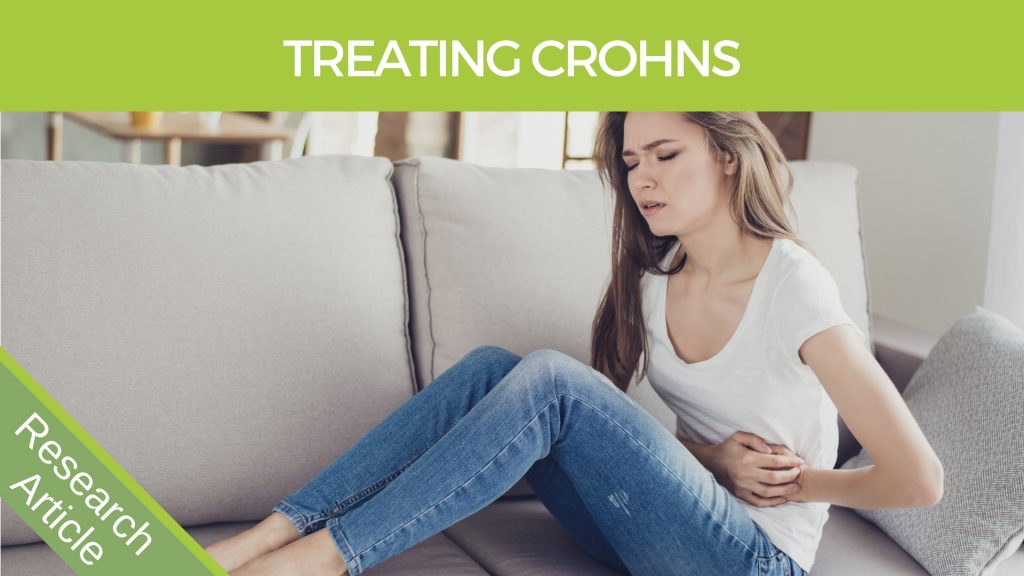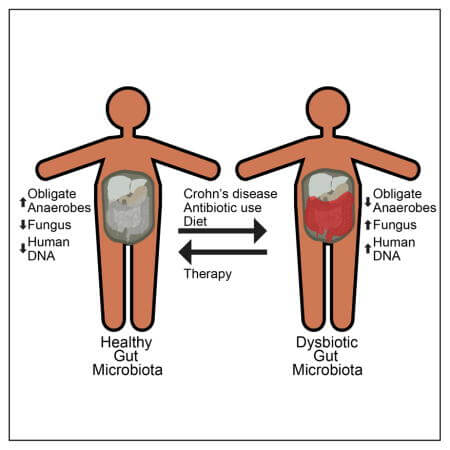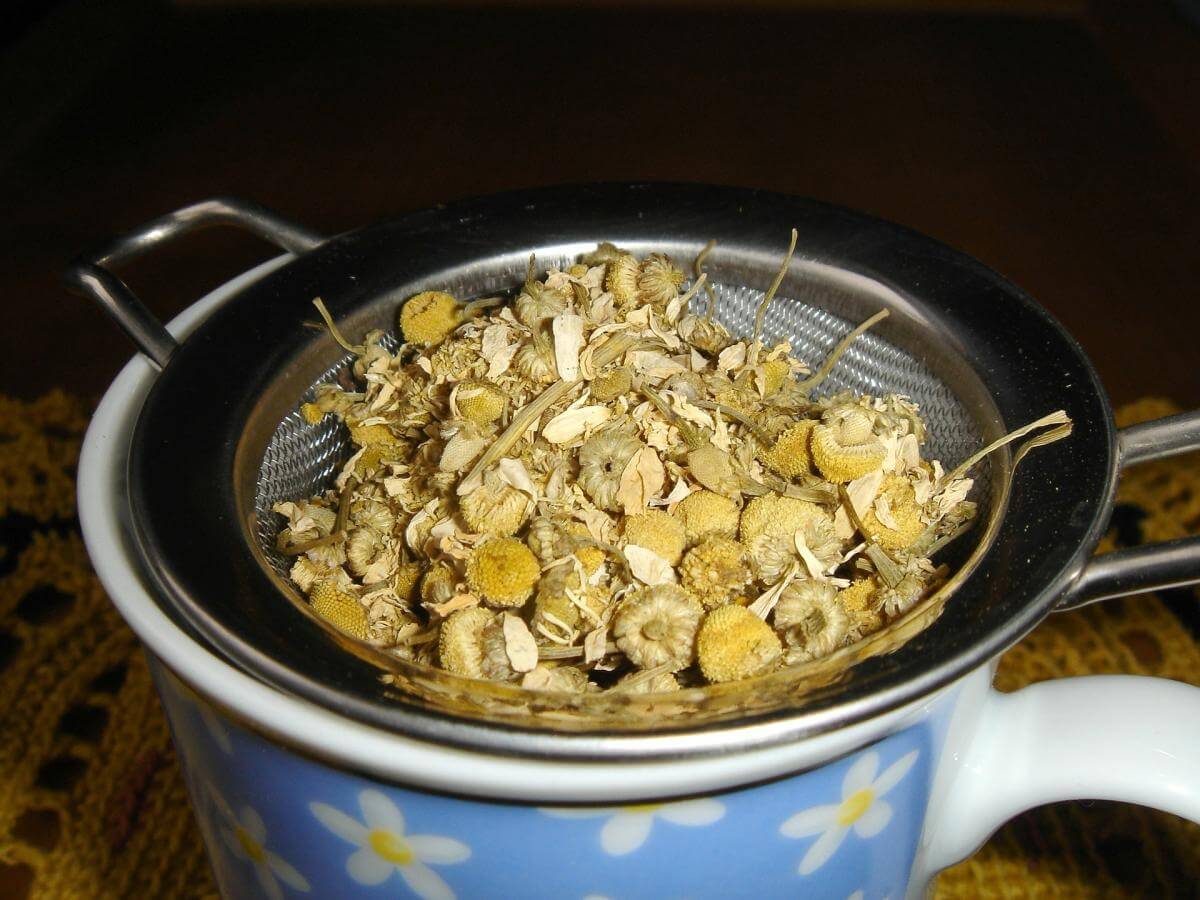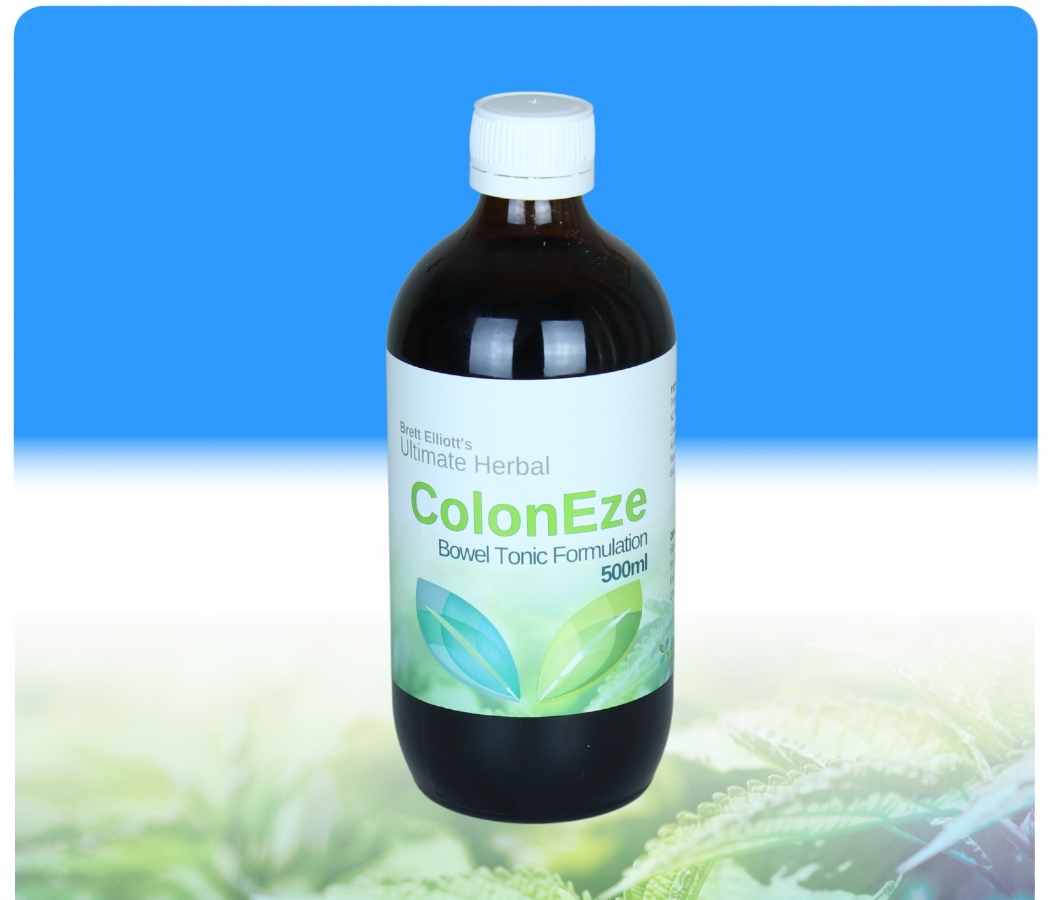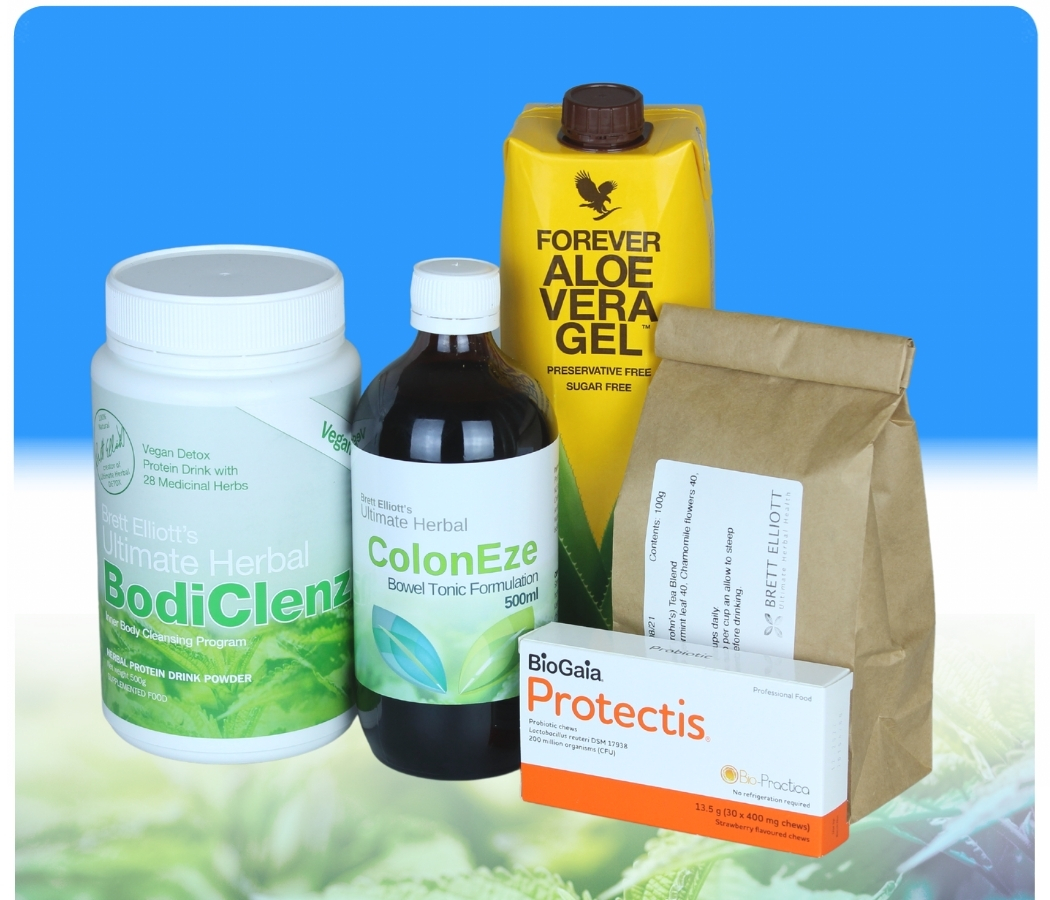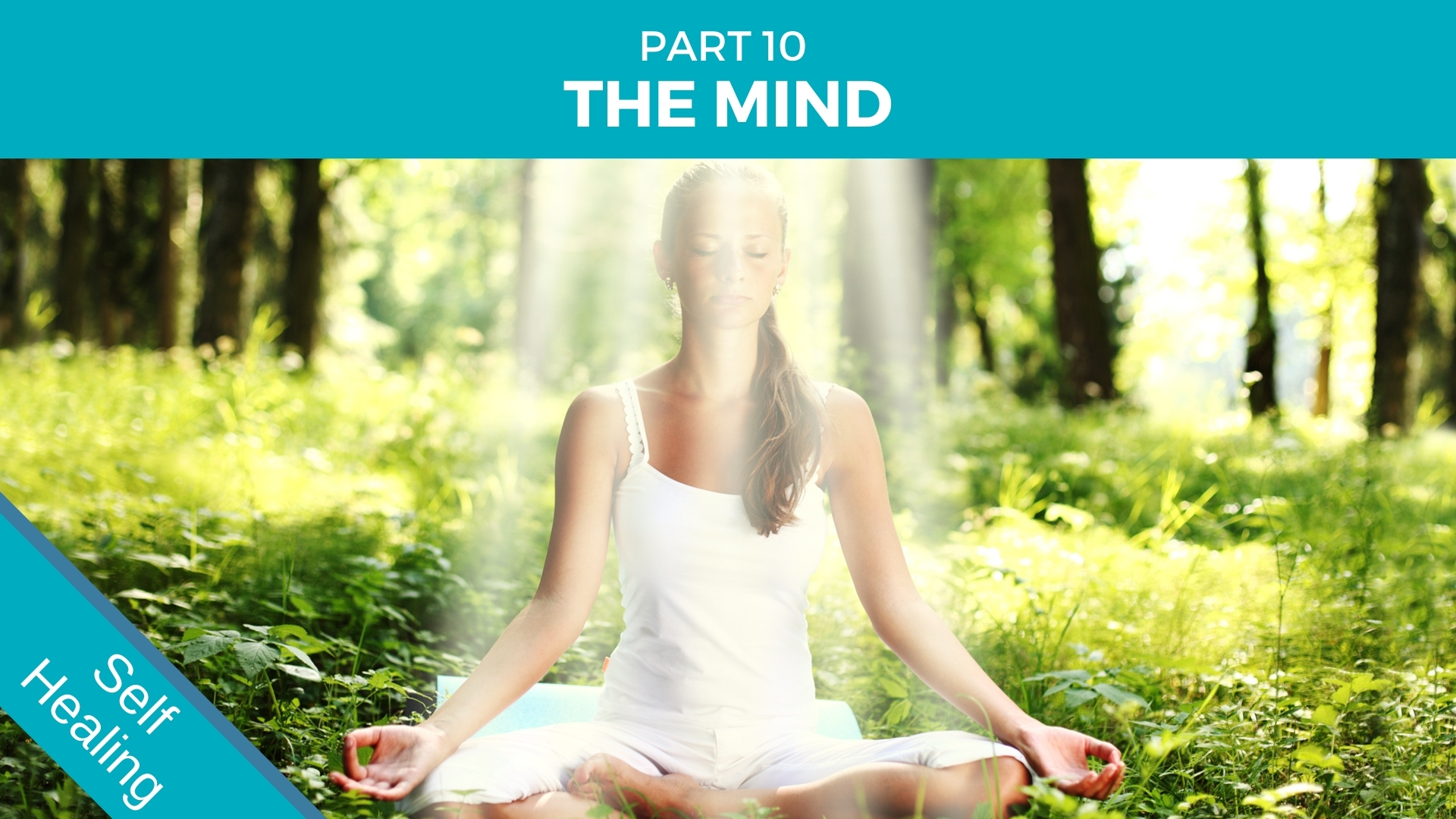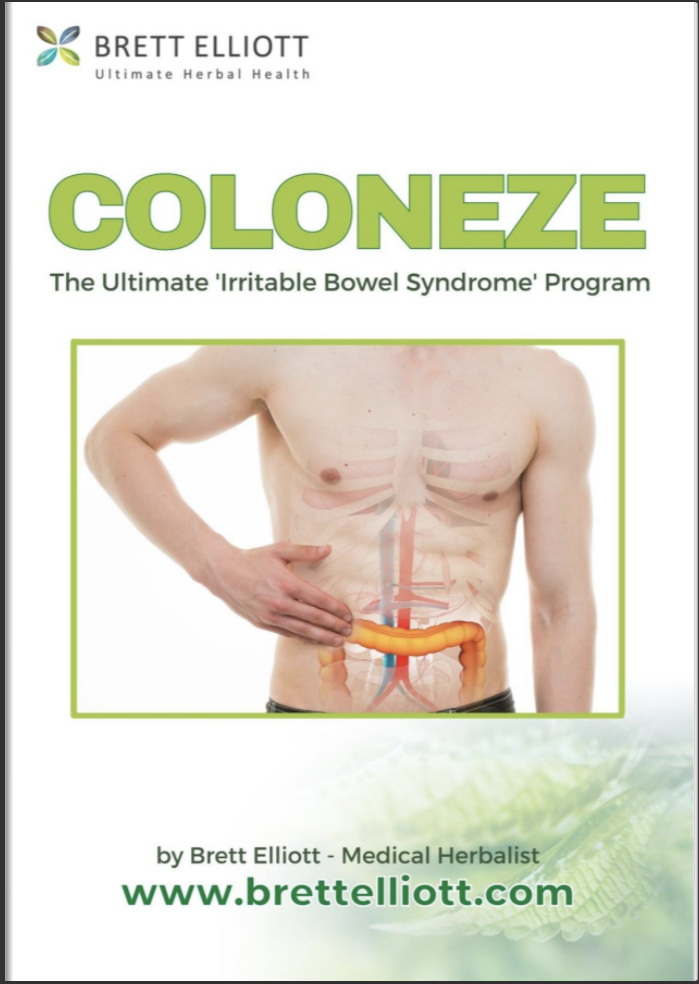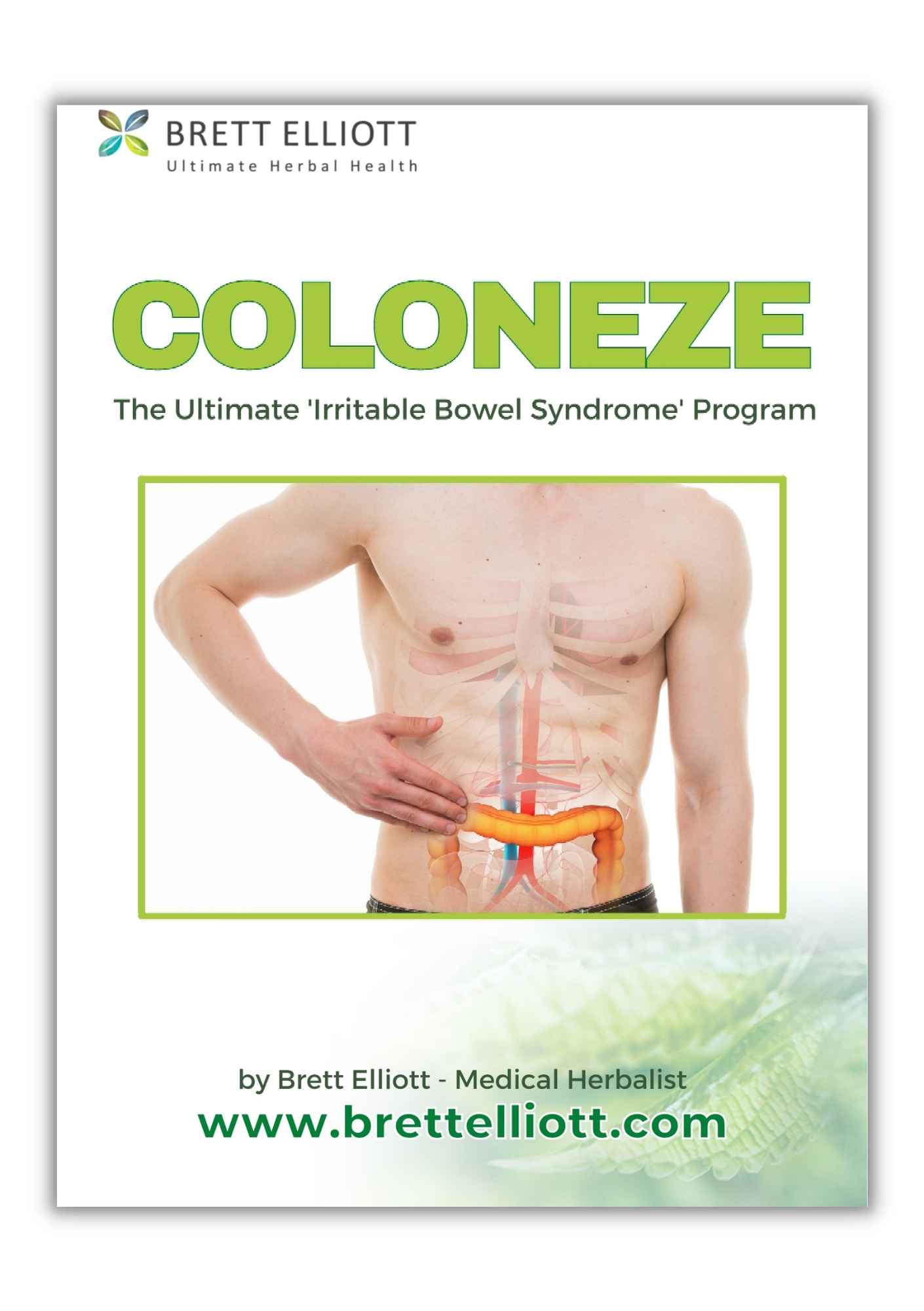- 2 years ago
- 19Minutes
- 3952Words
- 1164Views
Crohn’s Disease Treatment. There is hope!
Being one of the most painful and difficult digestive complaints to treat, Crohn’s disease is a growing problem worldwide. It can be confused with Ulcerative colitis, irritable bowel syndrome, and gastric ulcers. If you are suffering from it you may find yourself quite despairing when looking for treatment solutions. This is because the cause and cure alike are almost a complete mystery to modern medicine. Crohn’s disease treatment is seen as an attempt to reduce symptoms, while a Crohn’s disease cure has still not been discovered. The time has now come to open up your options.
Today I will share with you the holistic view, covering food, herbs, and mind-body medicine giving you a new ray of hope. Many people have completed our program and reported success at relieving the symptoms of Crohn’s disease. The key to healing is to make the complex simple, and this is what I will aim to achieve. Simple natural solutions may require a little effort but can be well worth the reward. Life’s journey is all about learning, growing, and ultimately healing, Let’s begin.
What is Crohn’s Disease
Crohn’s disease (CD) is a chronic relapsing inflammatory bowel disease. It is characterized by a transmural granulomatous inflammation (ulcers) which can affect any part of the gastrointestinal tract, most commonly the ileum, colon (small and large intestine), or both. It affects 1 in 500 – 700 of the population. Its prevalence has continually increased over the past 50 years with the highest incidence being reported in northern Europe, the United Kingdom, and North America It usually affects the intestines but may occur anywhere within the Gastrointestinal tract from the mouth all the way to the anus.
The condition starts as small ulcers in the lining of the gut and these early ulcers are called “aphthous” ulcers. These are similar to mouth ulcers. It’s more common between the ages 15 – 40 and in people who smoke. It can also run in families. It was observed that in Canadian and New Zealand populations, females are 10–30% more likely to acquire the disease than males, whereas males with CD are reported as up to three times more likely in Japan and Korea. (6)
Crohn’s Disease Symptoms
Crohn’s disease symptoms vary in intensity over time and depend on what part of the Gastrointestinal tract is affected. Because the disease stems from inflammation deep in the intestinal wall called granulomatous inflammation (see diagram) and often results in ulceration. Crohn’s disease symptoms can be wide-reaching.
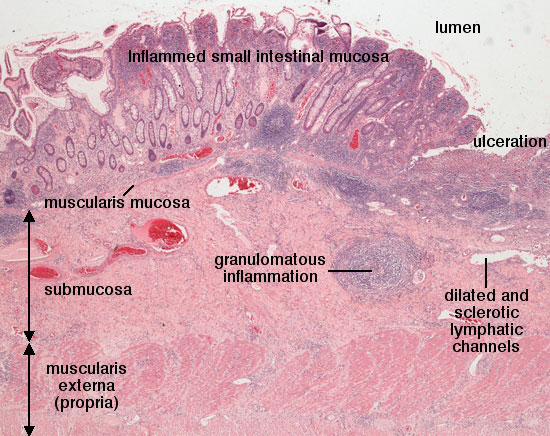
The most common Crohn’s symptoms include: Abdominal cramps and pain – Loss of appetite – Weight loss – Pain with passing stool – Persistent, watery diarrhea for more than 4 weeks – Blood and mucus in stools – Swollen gums – Weight loss – Increased Human DNA in feces Less common Crohn’s symptoms (35% of patients) – Mouth Ulcers – Peripheral joint pain and swelling – Erythema nodosum (fatty inflammation below the skin) – Ankylosing spondylitis – Eye Inflammation Very Rare Crohn’s symptoms – Psoriasis – Pyoderma gangrenosum (necrotic leg ulcers) – Sclerosing cholangitis (bile duct inflammation)
Crohn’s Disease Diagnosis
No single definitive diagnostic investigation exists for the diagnosis of CD. Full ileocolonoscopy with biopsies is currently the most widely used diagnostic investigation for Crohn’s Disease Diagnosis.. (6) Visual investigation Ultrasound, CT scan, and MRI can all be used, but a cross-section analysis of all three is most conclusive giving up to 90% accuracy. Capsule endoscopy is a relatively new, simple, noninvasive imaging technique that is gaining recognition for small bowel exploration. The investigation involves the consumption of a disposable, small, wireless camera within a capsule that passes through the gastrointestinal tract allowing direct visualization of the mucosa.
A meta-analysis comparing the diagnostic yield of capsule endoscopy to other imaging modalities found an increased diagnostic rate of 15% over the other methods. (6) Antibodies Perinuclear anti-neutrophil cytoplasmic antibodies (pANCA) and anti-Saccharomyces cerevisiae antibodies (ASCA) have been found in CD patients and the identification of these markers can help differentiate CD from ulcerative colitis where the diagnosis remains ambiguous. (6)
What causes Crohn’s disease?
According to modern allopathic medicine, the cause of Crohn’s disease is a complete mystery. All they know is that it’s an autoimmune disorder. An autoimmune disorder is a condition that occurs when your body’s immune system mistakenly attacks and destroys healthy body tissue. Why would the body do this? Obviously, there must be something going on with the gut tissue that the body identifies as foreign to the body’s healthy tissue and is worth mounting an attack on. Some kind of toxin, irritant, allergen, pathogen, bacteria, or other invading microbe is what most commonly triggers an immune response.
The bacteria Helicobacter pylori can be detected in the oral mucosa or ulcerated lesion of some patients with recurrent aphthous (ulcers) like those seen in Crohn’s disease. (2) Those who suffer from CD have chronic inflammation of the gastrointestinal tract Crohn’s disease may involve the small intestine, the large intestine, the rectum, or the mouth. Because the generation of pANCA and ASCA antibodies occurs most likely from an abnormal response of the intestinal mucosal immune system to intestinal flora there appears a direct link between gut flora/microbiota.
When the gut microbiota is out of balance and overpopulated with negative bacteria like Helicobacter pylori the immune system will be activated to attack the invader, eventually becoming confused thus beginning to attack the intestinal lining itself. This will trigger a cascade of immune activity eventually resulting in an autoimmune attack. The common-sense approach would be to support healthy gut microbiota, reduce inflammation and encourage healing of the intestinal wall, supporting healthy immune responses and knocking back Helicobacter pylori. Let’s look at how we can do this holistically using natural foods and herbs.
Crohn’s Disease Treatment
Pharmaceuticals Corticosteroids are widely prescribed for the induction but not the maintenance of remission due to increasing resistance over time, patient dependence, and adverse side effects with long-term use. Anti-inflammatory 5-aminosalicylate drugs also have a long history of use but have failed to bring remission or prevent relapse over time. (6)
Immunosuppressant drugs are the other primary option for the conventional pharmaceutical approach. None of these approaches appear to address the underlying cause of the problem or promote any actual healing of the intestine, leaving surgery as the last resort. This is where foods and herbs come to the rescue as they really have the power to heal. We will start with food.
Crohn’s Disease Diet
Gut microbiota disturbances are associated with intestinal inflammation and antibiotic use. Antibiotic exposure is associated with increased dysbiosis (gut bacteria imbalance), whereas dysbiosis decreases with reduced intestinal inflammation. Fungal proportions (especially Candida) increased with disease and antibiotic use. Dietary therapy can have rapid effects on microbiota composition distinct from other stressor-induced changes and effectively reduces inflammation.
Findings reveal that dysbiosis results from the independent effects of inflammation, diet, and antibiotics, and this has shed new light on Crohn’s disease treatments. (7)
A high dietary intake of fats, polyunsaturated fatty acids, omega-6 fatty acids, and meats have both been associated with an increased risk of Crohn’s disease, while a high fiber and fruit diet has been seen to be protective. (6)
Too much fat, especially processed trans-fats has shown to be inflammatory. Little is known about the responses of microbial life to environmental stressors. Similarly, it is unknown whether dysbiosis resulting from inflammation is rapidly reversible. Patients with Crohn’s disease are often exposed to antibiotics and dietary changes that are likely to affect the microbiota, but the influence of these factors and their interactions with each other are not completely understood. Dysbiotic Crohn’s disease is associated with increases in specific fungi including Candida Albicans, prior antibiotic therapy, and a higher concentration of human DNA in feces. (7)
It would, however, suggest the combination of probiotics (Obligate Anaerobes) and an anti-inflammatory, anti-fungal diet and herbs could promote long-term healing of Crohn’s Disease.
See the diagram below. Don’t worry if this doesn’t make sense. It’s a little scientific and complex, but in a nutshell, let’s say this. A good Crohn’s disease diet plan will include lots of healthy micro-organisms to populate the gut, such as fruits, herbs, and vegetables.
Crohn’s disease diet plan.
Foods to avoid:
The types of foods that can make diarrhea and gas worse such as the brassicas, cauliflower, asparagus, Brussel sprouts, cabbage and broccoli, and too many beans or chickpeas Excessively high-fiber and roughage foods such as bran, beans, nuts, and seeds;
Too much fatty, greasy or over-cooked fried foods; Processed, dehydrated packaged foods; cereals, crackers, crisps, nachos, tacos, and biscuits; Foods from the nightshade family including potatoes, tomatoes, capsicums, and especially avoid smoking tobacco;
Cayenne pepper, on the other hand, is allowed as it can effectively reduce ulcers, pain, and inflammation because it knocks Helicobacter pylori; Gluten-containing foods; bread, pasta, pastry, cakes, muffins, buns, bagels, and slices;
Studies give strong support to the role of tube feeding, showing efficacy similar to corticosteroids and better improvements in growth and mucosal healing. it has been suggested that tube feeding might be used not only to achieve but also to maintain remission. Of course, this might work if you are bound to a hospital bed, but what if you want to continue with your normal active life.
It would appear that the easier food is to digest the more your gut will be allowed to heal. Smaller meals of easily digestible fruits and vegetables and a lot of liquids will encourage healing. (9)
Foods to eat more of on the Crohn’s diet:
Coconut milk & oil: Results of one study with rats showed that coconut milk and water had protective effects on the ulcerated gut wall. Coconut milk produced a stronger percentage (54%) reduction in the ulcer size than coconut water (39%). It is my recommendation to use coconut milk often and to cook with coconut oil also. (17)
Manuka Honey: Results of one study with rats indicated that Manuka honey is effective in the treatment of chronic ulcers and preservation of mucosal glycoproteins. Its effects are due to its antioxidant and anti-inflammatory properties. (18)
Citrus fruits: Several studies have evaluated the effectiveness of Citrus fruits derivatives and their bioactive compounds against Helicobacter pylori, gastric carcinoma, and urease activity, suggesting that, either alone or in combination with antibiotics, they could represent useful sources to help eradicate Helicobacter pylori and avoid gastric ulcer relapse. (19)
To help ease symptoms, try eating soothing healing foods such as stewed apples with cinnamon, avocado, salmon, brown rice, porridge, vegetable soups/broths, and plain unsweetened yogurt; Probiotic foods such as kefir, plain yogurt, sauerkraut Intake of fiber from fresh vegetables and fish have shown to reduce the risk of developing CD (8)
Eating smaller servings of food more frequently throughout the day rather than large meals, and Drink lots of water.
Culinary and digestive herbs you can eat often on the Crohn’s diet:
Basil, Cayenne, Cinnamon, Cloves, Mixed herbs, Nutmeg, Oregano, Parsley, Rosemary, Thyme, Turmeric These herbs are all anti-inflammatory, help improve digestion, and control gut microbiota. Try adding these herbs in vegetable soups, mild curry, or stir-fry.
Medicinal Herbs for Crohn’s Disease
Favorable results have been widely found from the use of herbal and plant products in inflammatory bowel disease. (12)
Aloe vera juice in large doses (50ml 2-3 times daily) will help with healing and give a reduction in pain. One study demonstrated that the Aloe Vera inner gel expresses antibacterial properties against both susceptible and resistant Helicobacter pylori strains. (1)
Subjects with genetic susceptibility to this infection may benefit from Helicobacter pylori eradication treatment with respect to Aphthous ulcers. (3)
In a double-blind, randomized, placebo-controlled trial, 44 hospital outpatients with mild to moderately active Ulcerative Colitis were randomly given oral Aloe Vera gel or placebo, 100 mL daily for 4 weeks. Oral administration of aloe vera produced a clinical response more often than placebo; it also reduced the histological disease activity and appeared to be safe. (10, 16)
Slippery Elm bark either in capsules or mixed with warm water (2.5gm twice daily) will also help with healing. Slippery elm contains mucilage, a substance that becomes a slick gel when mixed with water. It coats and soothes the mouth, throat, stomach, and intestines. It also contains antioxidants that help relieve inflammatory bowel conditions. Slippery elm causes reflux stimulation of nerve endings in the gastrointestinal tract leading to increased mucus secretion. The increased mucus production may protect the gastrointestinal tract against ulcers and excess acidity. (4)
Licorice; The anti-ulcer activity of licorice was found to be similar to that of common anti-ulcer drugs. (12) Another study showed that licorice is as effective as bismuth in H. pylori eradication. (11) Golden Seal:
Berberine an alkaloid found in Golden Seal, is an alternative medicine for treating bacterial diarrhea and intestinal parasite infections. Recent studies suggest that berberine exerts several other beneficial effects, including inducing anti-inflammatory responses. (14)
Wormwood: There was a steady improvement in CD symptoms in 18 patients (90%) who received wormwood in spite of tapering of steroids. After 8 weeks of treatment with wormwood, there was almost complete remission of symptoms in 13 (65%) patients in this group as compared to none in the placebo group. This remission persisted until the end of the observation period that was week 20, and the addition of steroids was not necessary. (15)
Herbal bitters blended in liquid forms (2.5 ml before meals) such as goldenseal, wormwood, gentian, Andrographis, milk thistle, dandelion, globe artichoke, and Gymnema will all help strengthen the entire digestive system and help reduce excess negative bacteria and inflammation. For example: “it is long known that the bitter constituents stimulate the gustatory nerves in the mouth and increase the secretion of gastric juice and bile, thereby promoting appetite and digestion” (5)
Herbal teas can also be beneficial for reducing pain and encouraging healing and these include chamomile, peppermint, ginger, and ribwort. A combination of as many of these remedies as possible would be suggested if you want to see results quickly. Natural treatments often bring about gradual healing over a period of months, so keep on track and allow yourself the time to heal properly. It’s worth it to get a long-term result that could last a lifetime. All of the above herbs are included in our Ultimate Crohn’s Disease program See Below
Body-Mind Crohn’s Disease Medicine

There is a powerful link between the brain and the gut.
It’s called the brain-gut axis it comprises a neural-neuroendocrine circuit between the brain’s hunger-satiety and hormonal reward systems in conjunction with the gut microbiota, which regulates our emotions and food-decision making. However, the consumption of high-sugar and high-fat diets has overridden this energy/pleasure circuitry to the point of addiction. (13)
Addiction, depression, and anxiety can all be linked to this gut-brain connection or disconnection. You may feel worried, embarrassed, or even sad and depressed about having a bowel condition and you may, therefore, be having a psychosomatic (mind-body) influence. The gut-brain connection is well documented and is, therefore, a major consideration.
Addressing negative attitudes and beliefs and learning to curb these influences can have a profound impact on any health condition, especially those relating to the intestine. This is because the intestine acts as our emotional brain and our emotions can be affected by our beliefs and attitudes.
Read more about Probiotics and the Gut-Brain connection
You have a powerful mind and the healing effects of positive thinking should be used whenever possible. Try meditation, reading, and perhaps some type of social activity that involves an emotional support network of kind friends.
Energy healing, massage, or other relaxation technique would be well worth investigating. learning and practice. Find something that resonates with you and take the plunge. Read more about meditation
I hope this has been helpful and has given you new hope in your search for solutions. Check out the Ultimate Crohn’s Program below. With a little time and effort, you can potentially say goodbye to Crohn’s.
Find out more about the Ultimate CROHN’S DISEASE Program below.
Brett Elliott ®
The Ultimate CROHN’S DISEASE Program

Healing The Gut Wall
There there’s nothing I have found better for healing the gut wall over the long term than Aloe Vera Juice. You will find it mentioned further below, but it’s worth looking at it and a little more detail if you’re really interested.
Aloe Vera has an amazing power to heal tissues and has a great reputation for speeding recovery from Burns and other tissue damage. Science doesn’t fully understand how it works yet, as it has over 200 active components in the Aloe Gel. I personally recommend this hello vera gel which has no additives or preservatives, or you could grow yours at home and make it yourself.
Watch this video if you want to try that. DOSE: Take 30ml daily first thing in the morning on an empty stomach. 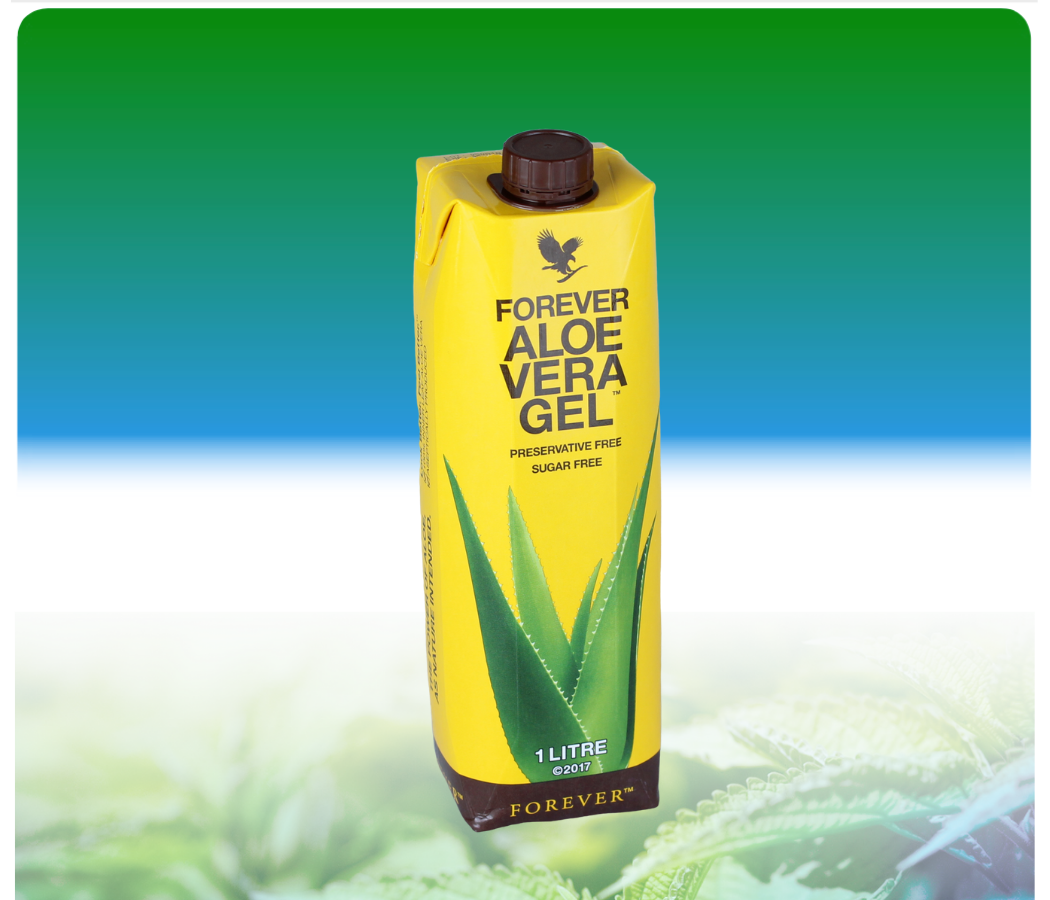 Get my Recommended Aloe Here
Get my Recommended Aloe Here
Gut Microflora
Diet has a marked impact on gut microflora diversity, understandable given that resident micro-organisms obtain energy for growth via the metabolism of dietary nutrients. (13)
The effect of dietary fiber consumption on the intestinal microflora composition was reported from global population studies with very similar results. Using recent and long-term dietary questionnaires and stool samples from healthy human subjects, microflora analysis demonstrated that a diet low in fat and high in dietary fiber was associated with higher positive bacteria, but a diet high in fat was more highly associated with negative bacteria.
There has been growing concern that even short-term dietary changes, particularly to a ‘Westernised’ style diet (high animal fat, high sugar, and low in plant-based fiber) can rapidly alter the composition and metabolic activity of resident intestinal microflora, with decreased levels of beneficial bacteria and increased numbers of bile-tolerant, inflammation-associated bacteria (13)
I suggest using the powerful Human prebiotic strain L-Reuteri, which you can get in the product called BioGaia. Take 2 tablets daily for the first month and 1 tablet daily for the second month.
Click here to find out more. DOSE: Take 1 tablet with water just before Dinner 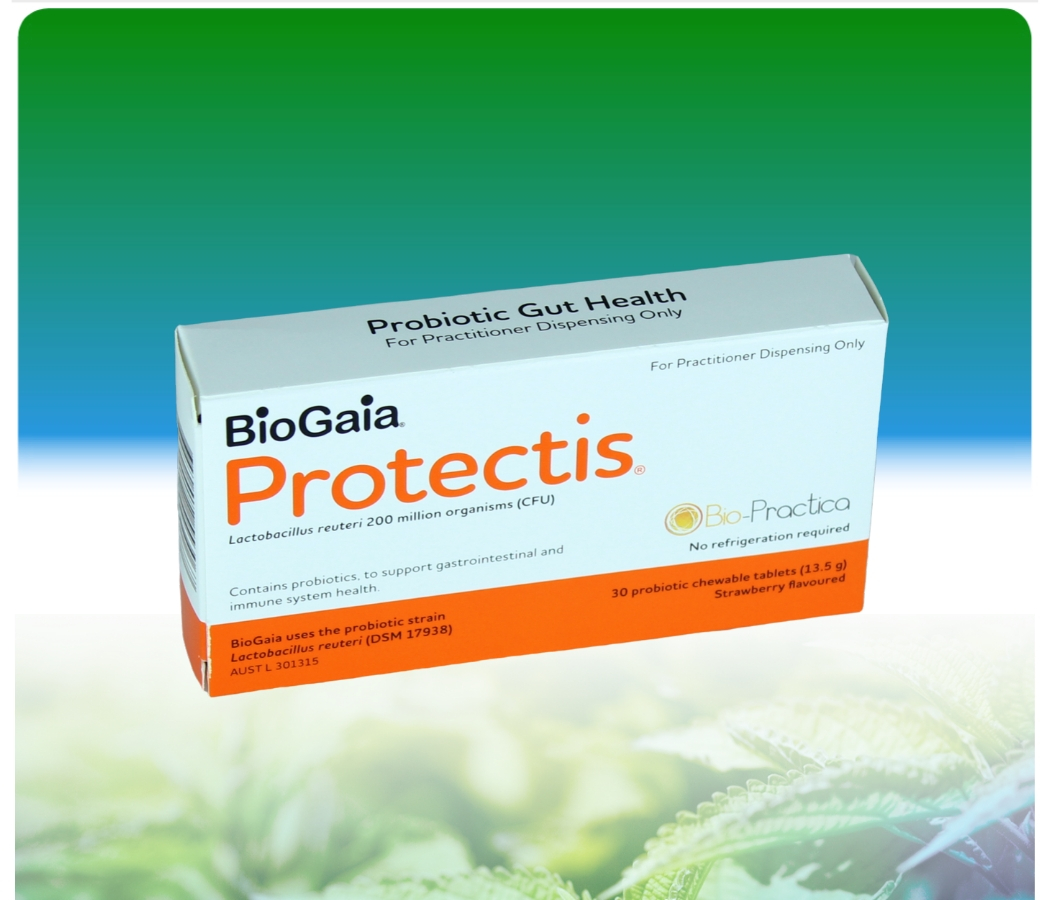
Intestinal permeability
The gut barrier plays a key role in the avoidance of inflammatory responses to the microflora and is regulated by a finely tuned network of immune mechanisms (3)
Because increased intestinal permeability and inflammation go hand in hand, natural methods to reduce intestinal inflammation will be useful. A diet rich in plant and vegetable fiber has been shown to greatly reduce inflammation.
A recent demonstration from the Nurses Health study that subjects had a 50% lower risk for the development of Crohn’s disease, which was directly associated with long-term ingestion of a diet rich in fruit and vegetable fiber. (13)
The Herbal Detox diet plan promotes a pure fruit and vegetable diet and has been reported to assist with inflammatory bowel disease. Powerful triggers for inflammation are the presence of microorganisms in sites where they do not belong. Microorganisms contain structures alien to the body.
Bacteria and fungi, for example, have cell walls in contrast to human cells that lack these structures, and viruses have unique forms of DNA and RNA. Cells and molecules involved in the inflammatory defense system react immediately against these foreign elements; they are danger signals to the body. (15)
Again this points to supporting the microflora, as above, which also introduces antiparasitic, antifungal, and anti-inflammatory agents. Traditional herbal remedies include:
Herbal Medicine
One of the most effective things I have seen help with Chrohn’s Disease is the 14-day herbal Bodiclenz program. It contains a combination of 24 herbs designed to support bowel health and digestive processes. You simply take the powder twice a day and a smoothie for two weeks.
I highly recommend using these two recipes every day if possible, StomachClenz and BowelClenz. DOSE: Take 2 scoops daily in a smoothie as your Breakfast and Lunch 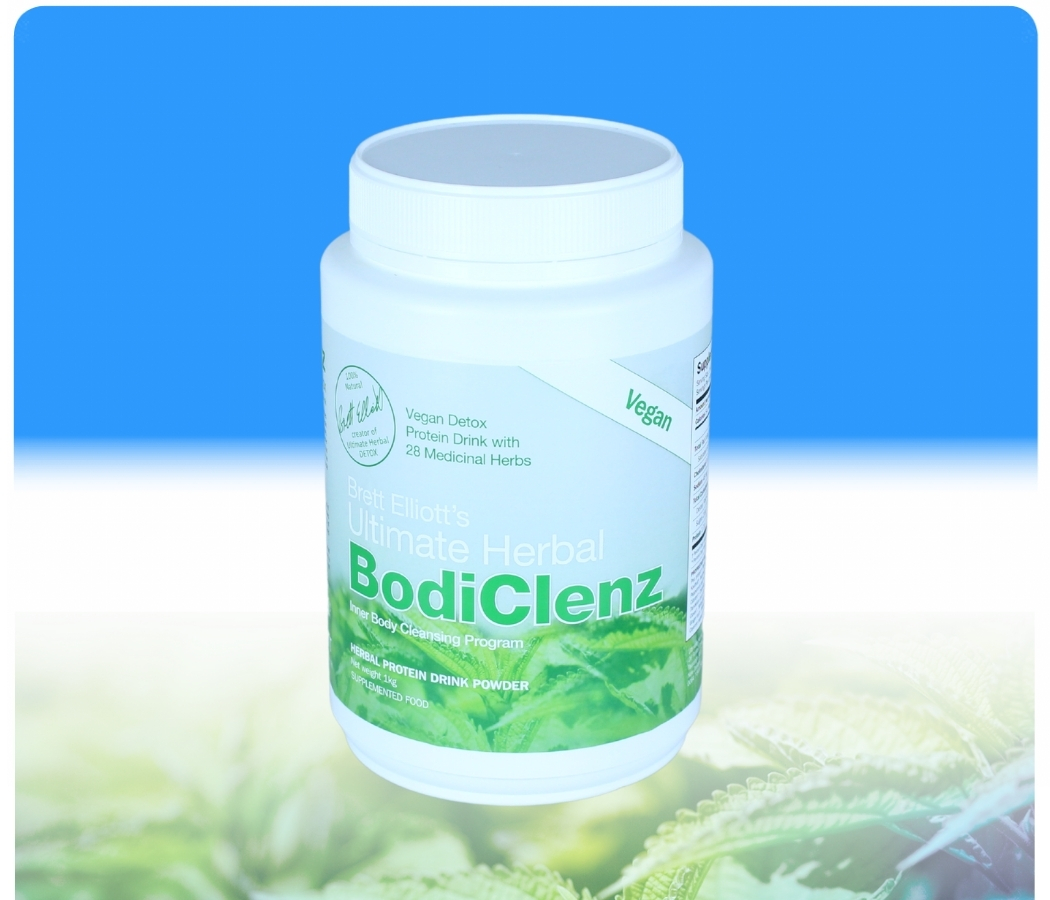
Some of the anti-inflammatory herbs traditionally used to encourage healthy microflora, heal the gut wall, and reduce negative bacteria and parasites include the following herbs, all of which are contained in the BodiClenz formulation.
DOSE: Take 10ml twice daily away from food. Repeating some of these herbs in a liquid formulation, and adding a couple of extra anti-inflammatory, immune-supporting herbs in a liquid will help increase the effect of the powered herbs taken in a smoothie.
– Licorice
See the ColonEze Liquid Formulation Here Herbal Teas to reduce inflammation and intestinal permeability:
– Raspberry
– Peppermint
– Chamomile
– Ginger
Try a mixture of these teas in your teapot and drink 2-3 cups daily. You can get this blend pre-made here. You will just need to add some fresh ginger. DOSE: Take 2-3 cups daily from a teapot, great in the evening.
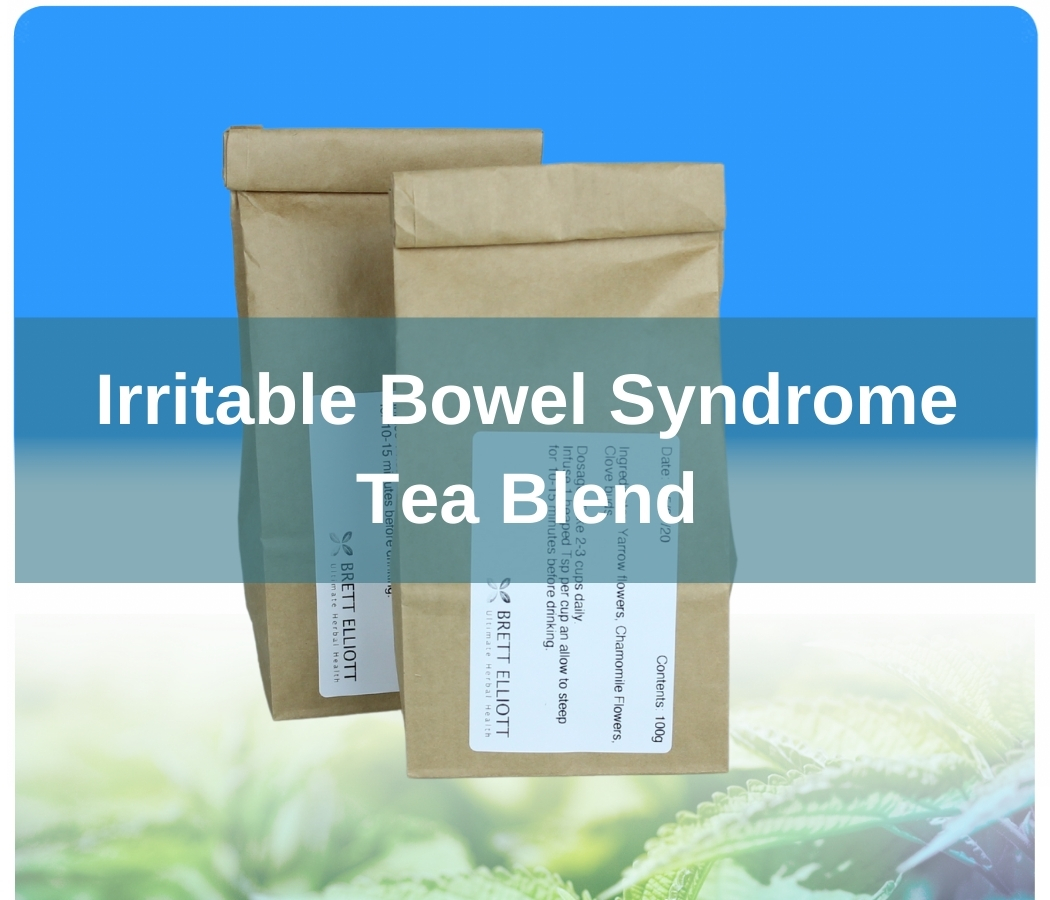
Get everything in one complete package, and save 30%. The Ultimate IBS and Crohn’s Program comes with everything you need for the full 1-month treatment program. Click Here to Find out more
Meditation
Going back to the brain-gut connection, there is an important role for the nervous system to play in Crohn’s Disease. Meditation can play a major role here. One randomized controlled trial demonstrated that mindfulness training has a substantial therapeutic effect on bowel symptom severity, improves health-related quality of life, and reduces distress. (7)
Interestingly, changes in quality of life, psychological distress, and visceral anxiety were not significantly different between groups immediately after treatment but evidenced significantly greater improvements in the meditation group at the 3-month follow-up.
(7) This makes sense, as the effects of meditation are known to increase over time. Read more Here

